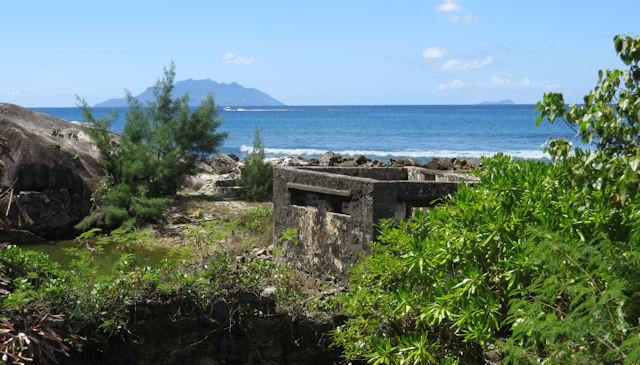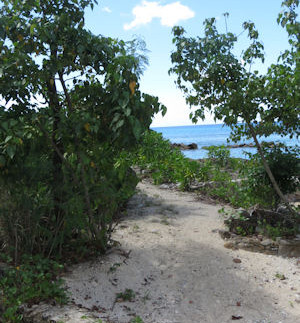The pirate treasure of Bel Ombre
- Steven Blum
- 21. Okt. 2023
- 4 Min. Lesezeit
Aktualisiert: 15. Sept. 2024
Seychelles’ Beau Vallon Bay brings treasure hunters from all over the world. It’s said that a massive amount of pirate booty has been hiding here for over 250 years, and visitors and locals with the doubloon-bug can still be found searching feverishly for the lost treasure today. Among the hidden loot, there are alleged to be diamonds that were taken from the Nossa Senhora do Cabo e São Pedro, a famed Portuguese ship captured near Saint Denise in 1721 by the legendary buccaneer La Buze.

Author Steven Blum at Bel Ombre Treasure Site Seychelles
Between 1715 and 1730, the pirate Olivier Le Vasseur, who is said to have led some 750 rough-and-ready pirate followers, was the terror of the French, British and Portuguese merchant fleets. Known as La Buze, or "the buzzard", Le Vasseur would circle around the sea like a bird of prey, striking with lightning speed and disappearing with his prey just as quickly.
La Buze, together with the famous pirates Blackbeard, Charles Vane, Sam Bellamy, Paulsgrave Williams, Stede Bonnet, Benjamin Hornigold, Henry Jennings, Calico Jack Rackham, Mary Read, Anne Bonny, belonged to the "Flying Gang" of the "Republic of Pirates" in Providence in the Bahamas. However, he had to flee the Caribbean as pirate hunting intensified in the area, deciding to make the crossing to the Gulf of Guinea together with pirate captains Thomas Cocklyn and Howell Davis. Here they would capture several merchant ships that were on their way from Asia to Europe by sea. La Buze later decided to campaign with Captain John Taylor in the Indian Sea and soon they controlled a sea area stretching from India to Africa and from the Arabian Peninsula to Madagascar. The large island to the east of Africa was the pirates’ main base: they even proclaimed their own republic here, dubbed ‘Libertalia’. On 26 April 1720, La Buze captured the Nossa Senhora just off the coast of the city of Saint Denis on the island of Réunion. Prominent passengers included the Archbishop of Goa and the Count of Ericeira, Viceroy of Portuguese India. It was a particularly fruitful steal. The count, it is said, was carrying a sword decorated with diamonds, and the bishop Dom Sebastião de Andrade Pessanha had in his luggage the legendary golden cross of Goa, a church treasure strewn with emeralds and rubies. Gold and silver ingots, coins, valuable fabrics, precious tableware, priceless stones and pearls were all part of a booty that today, historians value at up to 4.5 billion Euros. La Buze fled with the stolen goods to hide the treasure at a suitable hiding place. However, he did not head to his main base on Madagascar, but to the Seychelles.
The islands were the perfect retreat for pirates, as the archipelagic islands were largely uninhabited until being settled by the French in 1770. The tropical refuge had hidden bays and mountains from which the pirates could keep a look out for their foes. There were also freshwater springs and enough giant turtles to stockpile for provisions in preparation for the next raid.
The lawless journeymen apparently roamed through the undergrowth, clambering through the many granite caves to find a suitable hiding place. It is believed that La Buze hid his treasure in such a way that it can only be found again at a certain water level.
After this particularly audacious stunt, La Buze and Captain John Taylor circumnavigated the southern tip of Madagascar and captured the anchored "La Duchesse de Noailles" in the bay of Saint-Augustin. They then set course for the bay of Delagoa – today’s Maputo in Mozambique - where they conquered the fortress and kidnapped the Dutch hydrographer Jacob de Bucquoy. Afterwards they sailed to Madagascar, where the two pirates fell out with each other and separated.
After the break up, La Buze abandoned the world of piracy and accepted an offer of amnesty from the King of France and the Governor of Bourbon Island. Some time around 1729, he began working as a pilot in Antongil Bay, Madagascar, where he offered his services to passing ships. The captain of the ship La Méduse of the East Indian Company recognized him and captured him. Clapped in irons, he was transferred to the island of Bourbon (now Réunion) to be sentenced.
Before his execution, the pirate told his guards: "With what I hid here, I could buy this whole island". What’s more, just before his execution he is said to have thrown a cryptogram into the crowd that stood in front of the gallows bearing both the words "Mes trésors à qui saura comprendre! ("My treasure to the one who understands this") and the directions to his hidden treasure. The encrypted document is yet to have been deciphered.
Later, the deceased big game hunter from England Reginald Cruise Wilkins would make the search for the treasure his life's work, believing the booty to be resting in a cave in Bel Ombre. The more cynical among us may regard the proverbial pirate treasure as a legend, but for the Seychelles authorities, the treasure - with an estimated value of 200 million dollars - is essentially official. Entering the excavation site is still strictly forbidden.
























Comments